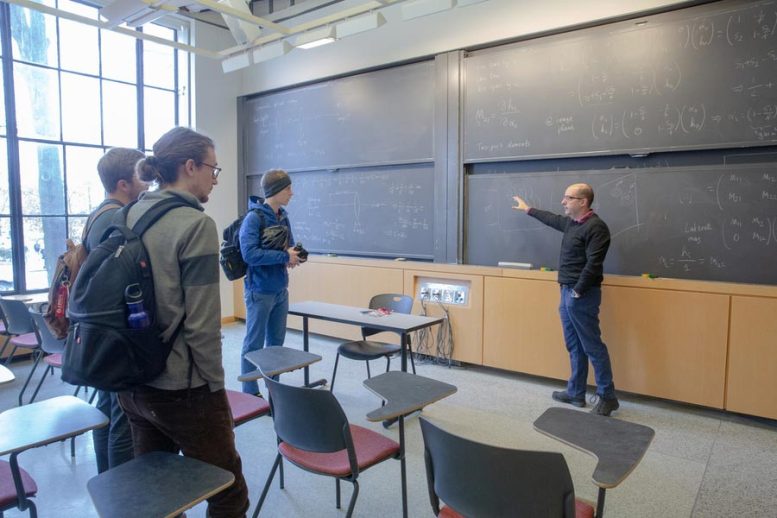
In MIT 2.C161, George Barbastathis demonstrates how mechanical engineers can use their knowledge of physical systems to keep algorithms in check and develop more accurate predictions.
A new MIT course merges machine learning with physics to help mechanical engineering students understand and solve the “black box” problem of AI. Through hands-on projects and ethical consideration, students learn to make informed, reliable predictions in physical systems.
Machine-learning algorithms are often referred to as a “black box.” Once data are put into an algorithm, it’s not always known exactly how the algorithm arrives at its prediction. This can be particularly frustrating when things go wrong. A new mechanical engineering (MechE) course at MIT teaches students how to tackle the “black box” problem, through a combination of data science and physics-based engineering.
In class 2.C161 (Physical Systems Modeling and Design Using Machine Learning), Professor George Barbastathis demonstrates how mechanical engineers can use their unique knowledge of physical systems to keep algorithms in check and develop more accurate predictions.
“I wanted to take 2.C161 because machine-learning models are usually a “black box,” but this class taught us how to construct a system model that is informed by physics so we can peek inside,” explains Crystal Owens, a mechanical engineering graduate student who took the course in spring 2021.
As chair of the Committee on the Strategic Integration of Data Science into Mechanical Engineering, Barbastathis has had many conversations with mechanical engineering students, researchers, and faculty to better understand the challenges and successes they’ve had using machine learning in their work.

“One comment we heard frequently was that these colleagues can see the value of data science methods for problems they are facing in their mechanical engineering-centric research; yet they are lacking the tools to make the most out of it,” says Barbastathis. “Mechanical, civil, electrical, and other types of engineers want a fundamental understanding of data principles without having to convert themselves to being full-time data scientists or AI researchers.”
Additionally, as mechanical engineering students move on from MIT to their careers, many will need to manage data scientists on their teams someday. Barbastathis hopes to set these students up for success with class 2.C161.
Bridging MechE and the MIT Schwartzman College of Computing
Class 2.C161 is part of the MIT Schwartzman College of Computing “Computing Core.” The goal of these classes is to connect data science and physics-based engineering disciplines, like mechanical engineering. Students take the course alongside 6.C402 (Modeling with Machine Learning: from Algorithms to Applications), taught by professors of electrical engineering and computer science Regina Barzilay and Tommi Jaakkola.
The two classes are taught concurrently during the semester, exposing students to both fundamentals in machine learning and domain-specific applications in mechanical engineering.
In 2.C161, Barbastathis highlights how complementary physics-based engineering and data science are. Physical laws present a number of ambiguities and unknowns, ranging from temperature and humidity to electromagnetic forces. Data science can be used to predict these physical phenomena. Meanwhile, having an understanding of physical systems helps ensure the resulting output of an algorithm is accurate and explainable.
“What’s needed is a deeper combined understanding of the associated physical phenomena and the principles of data science, machine learning in particular, to close the gap,” adds Barbastathis. “By combining data with physical principles, the new revolution in physics-based engineering is relatively immune to the “black box” problem facing other types of machine learning.”
Equipped with a working knowledge of machine-learning topics covered in class 6.C402 and a deeper understanding of how to pair data science with physics, students are charged with developing a final project that solves for an actual physical system.
Developing Solutions for Real-World Physical Systems
For their final project, students in 2.C161 are asked to identify a real-world problem that requires data science to address the ambiguity inherent in physical systems. After obtaining all relevant data, students are asked to select a machine-learning method, implement their chosen solution, and present and critique the results.
Topics this past semester ranged from weather forecasting to the flow of gas in combustion engines, with two student teams drawing inspiration from the ongoing COVID-19 pandemic.
Owens and her teammates, fellow graduate students Arun Krishnadas and Joshua David John Rathinaraj, set out to develop a model for the COVID-19 vaccine rollout.
“We developed a method of combining a neural network with a susceptible-infected-recovered (SIR) epidemiological model to create a physics-informed prediction system for the spread of COVID-19 after vaccinations started,” explains Owens.
The team accounted for various unknowns including population mobility, weather, and political climate. This combined approach resulted in a prediction of COVID-19’s spread during the vaccine rollout that was more reliable than using either the SIR model or a neural network alone.
Another team, including graduate student Yiwen Hu, developed a model to predict mutation rates in COVID-19, a topic that became all too pertinent as the delta variant began its global spread.
“We used machine learning to predict the time-series-based mutation rate of COVID-19, and then incorporated that as an independent parameter into the prediction of pandemic dynamics to see if it could help us better predict the trend of the COVID-19 pandemic,” says Hu.
Hu, who had previously conducted research into how vibrations on coronavirus protein spikes affect infection rates, hopes to apply the physics-based machine-learning approaches he learned in 2.C161 to his research on de novo protein design.
Whatever the physical system students addressed in their final projects, Barbastathis was careful to stress one unifying goal: the need to assess ethical implications in data science. While more traditional computing methods like face or voice recognition have proven to be rife with ethical issues, there is an opportunity to combine physical systems with machine learning in a fair, ethical way.
“We must ensure that collection and use of data are carried out equitably and inclusively, respecting the diversity in our society and avoiding well-known problems that computer scientists in the past have run into,” says Barbastathis.
Barbastathis hopes that by encouraging mechanical engineering students to be both ethics-literate and well-versed in data science, they can move on to develop reliable, ethically sound solutions and predictions for physical-based engineering challenges.
Never miss a breakthrough: Join the SciTechDaily newsletter.